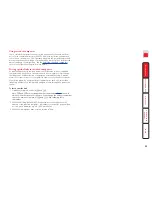
29
To apply remote user video compensation
1 Ensure that the video image from the computer to be used has been
correctly compensated. See
Computer video compensation
for details.
2 On the remote user keyboard (connected to a User Station extender),
simultaneously, press the hotkeys (by default,
and
) along with
to
enter configuration mode.
The three keyboard indicators (‘Num Lock’, ‘Caps
Lock’ and ‘Scroll Lock’) will now begin to flash in
sequence. The speed of the sequence indicates the
level of the sharpness adjustment currently applied:
the slower the rate, the lower the level of sharpness
being applied.
3 While viewing the displayed screen image, use the following keys to adjust
the controls:
Sharpness:
for fine adjustment, for coarse adjustment.
There are 255 sharpness levels (one coarse step jumps 10 levels).
To autoset sharpness:
Press to make the module
calculate and apply an automatic compensation level - you can
use this as a starting point for your fine tuning.
Note: If the monitor goes blank and switches off (due to oversetting
the sharpness adjustment) press the Home key to restore.
Brightness:
for adjustment. There are 255 brightness levels.
Sharpness
increase
(coarse)
Sharpness
decrease
(coarse)
Sharpness
increase
(fine)
Sharpness
decrease
(fine)
Brightness
increase
Brightness
decrease
Restore default
sharpness and
brightness
settings
Exit image
controls
and save
settings
If the image controls cannot provide a crisp image
If, after adjusting the image controls, one or more screen images remain
fuzzy or have coloured shadows you may need to use the Skew adjustment
feature. Please see
Remote user skew adjustment
for details (User
Station C5 Pro module only).
Remote user video compensation
Video compensation for each remote user is provided by their User Station
modules, not by the MC5 unit itself. Using the User Station controls you can
adjust the picture sharpness and brightness to improve the remote picture
quality.
Note: Accurate remote user compensation relies upon visual feedback from the
screen image. It is therefore vital to ensure that the video images being sent out
from the MC5 are as ‘true’ as possible. Ensure, using the local user port, that the
video images received from the computers are correctly compensated BEFORE
attempting to adjust the remote user(s).
Video compensation is best carried out when viewing high contrast images with
vertical edges, such as black lines on a white background. When doing so, if you
notice that the screen image is ‘fuzzy’ or ‘dark’ then the image controls may not
be able to solve this condition.
Note: If the high contrast images exhibit shadows with separate colours, then
there may be a skew problem which requires a different image adjustment
(provided only by User Station C5 Pro modules) - see the
Remote user skew
adjustment
section for details.
To display a suitable high contrast image
The best way to clearly view the effect of sharpness and brightness adjustments
is to display a high contrast image, with vertical
edges, on the screen.
• Open a word processor, type the capital letter
‘H’, or ‘M’ and increase the point size to 72
or higher. For best results, the background
should be white and the character should be
black.
• A BLACK shadow on the right of the character
indicates UNDER compensation.
• A WHITE shadow on the right of the character
indicates OVER compensation.
Note: The Word processor method is accurate and quick. However, for the very
finest video compensation, use the latest “skew” test pattern program which
shows both the skew pattern and a section of mixed size Hs (black on white and
white on black).
High contrast
black character
on white
background
Black or bright
white shadow
on the right
indicates
the need for
sharpness
adjustment
4 When no shadows are visible and the displayed images have crisp edges,
press
to exit configuration mode and permanently save all settings.
The new compensation settings will be stored, even when power is removed
or if a complete reset is initiated. These settings should not require further
changes unless the cabling arrangements are altered.
















































